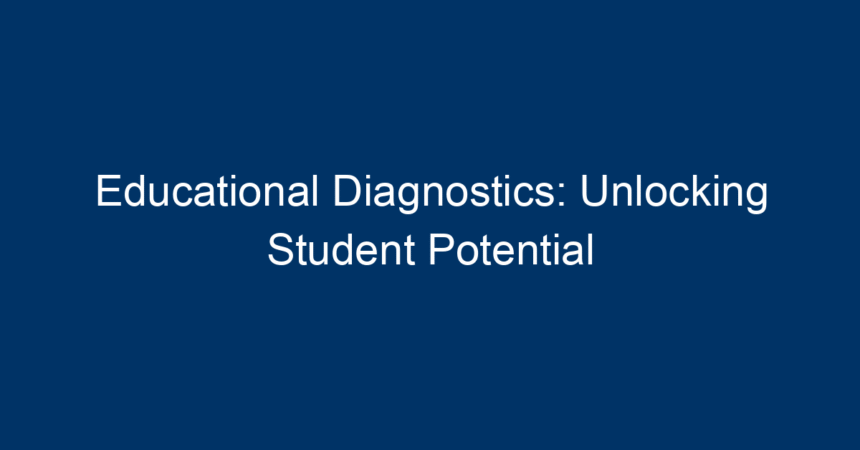In today’s rapidly evolving educational landscape, the need to effectively assess and understand each student’s unique learning needs has never been greater. Enter educational diagnostics—an approach designed to identify the strengths and weaknesses of learners to tailor educational experiences that foster growth and achievement. This article delves into the importance of educational diagnostics, its methodologies, and how it can unlock student potential.
Understanding Educational Diagnostics
Educational diagnostics refers to the systematic process of evaluating students’ learning capabilities, challenges, and styles. This nuanced approach goes beyond standard testing; it employs various tools and strategies to paint a comprehensive picture of a learner’s academic profile.
Purpose of Educational Diagnostics
The primary purpose of educational diagnostics is to:
- Identify Learning Needs: By assessing a student’s academic performance and potential, educators can identify specific areas that require attention.
- Guide Instructional Strategies: Understanding a student’s diagnostic profile allows teachers to customize their instructional methods, ensuring they meet each learner where they are.
- Enhance Learning Outcomes: Effective diagnostics pave the way for setting achievable goals, leading to improved academic performance.
The Importance of Educational Diagnostics
Personalized Learning Experience
One-size-fits-all approaches in education often overlook individual differences among students. Educational diagnostics provide a framework for creating personalized learning pathways. When educators understand a student’s strengths and weaknesses, they can develop a tailored curriculum that fosters engagement and motivation.
Early Intervention
Identifying potential learning difficulties at an early stage can drastically alter a student’s academic trajectory. Through educational diagnostics, teachers can spot warning signs of learning challenges, enabling timely intervention. This proactive approach not only mitigates future struggles but also boosts a student’s confidence and self-esteem.
Inclusion and Equity
Education should be accessible to all, yet diverse learning styles and needs can create barriers. Educational diagnostics promote inclusivity by ensuring that all students receive the support necessary for success. When educators understand the unique backgrounds and experiences of their students, they can implement strategies that celebrate diversity and promote equity.
Methods of Educational Diagnostics
Educational diagnostics employs a variety of methodologies to assess students comprehensively. Let’s explore some of the most effective techniques.
Standardized Testing
While standardized tests have their limitations, they still serve a purpose in educational diagnostics. These assessments can provide baseline data regarding a student’s academic performance compared to peers. However, they should be used in conjunction with other diagnostic methods to create a complete profile.
Observational Assessment
Educators often underestimate the power of observation. Through careful observation in the classroom, teachers can gather qualitative data on students’ learning behaviors, social interactions, and engagement levels. This method helps in understanding a student’s context and informs instructional decisions.
Formative Assessments
Formative assessments, such as quizzes, projects, and classroom discussions, offer continuous feedback on student understanding. These tools help educators monitor progress over time, allowing for timely adjustments to teaching methods.
Student Feedback
Engaging students in their own learning journey is crucial. Gathering feedback through surveys or discussions helps educators understand how students perceive their challenges and strengths. This collaboration fosters a growth mindset and empowers learners to take ownership of their educational experiences.
Implementing Educational Diagnostics in the Classroom
Creating a Supportive Environment
A positive learning environment is the foundation for effective educational diagnostics. Educators should foster open communication where students feel comfortable expressing their needs and challenges. Building rapport and trust will encourage students to be more forthcoming about their learning experiences.
Training Educators
For educational diagnostics to be effective, teachers must be trained in the methodologies and tools available. Professional development programs should emphasize the importance of understanding diverse learning needs and the use of diagnostic assessments.
Collaboration with Specialists
Collaborating with educational specialists, such as school psychologists and special education teachers, enhances the diagnostic process. These professionals can provide additional insights and strategies to support a diverse student population.
Utilizing Technology
Incorporating technology into educational diagnostics can streamline assessments and data collection. Learning management systems (LMS) and educational software can offer analytics that help educators identify trends and patterns in student performance.
Case Studies: Success Stories
Improving Literacy Rates
In a primary school setting, educators implemented educational diagnostics to assess students’ literacy skills basing instruction on identified strengths and weaknesses. The result was a 30% increase in literacy rates within one academic year, showcasing the power of tailored interventions.
Special Education Triumphs
A high school district utilized educational diagnostics to develop Individualized Education Plans (IEPs) for students with special needs. By closely monitoring progress and adjusting strategies as needed, these students achieved significant academic milestones, emphasizing the importance of targeted support.
Challenges and Considerations
While educational diagnostics offers numerous benefits, it is essential to address potential challenges:
Time Constraints
Implementing thorough educational diagnostics requires time for assessment, interpretation, and intervention. Educators may feel overwhelmed, especially when juggling multiple responsibilities.
Misinterpretation of Data
Interpreting diagnostic data can be complex. Misunderstandings can lead to inappropriate interventions or support that fails to meet a student’s actual needs. Professional training and support systems can mitigate this risk.
Emotional Impact
For some students, diagnostic assessments may evoke anxiety or stress. It’s crucial to approach diagnostics with sensitivity, ensuring students understand the purpose and benefits of the process.
Conclusion: Unlocking Potential through Educational Diagnostics
In conclusion, educational diagnostics is a vital component of modern education that has the potential to unlock the full potential of every student. By understanding individual needs through various assessment methods, educators can create personalized learning experiences that promote growth and achievement.
Actionable Insights
- Incorporate Multiple Assessment Techniques: Use a variety of assessment methodologies to gain a fuller understanding of each student’s needs.
- Invest in Professional Development: Provide teachers with training on how to implement educational diagnostics effectively.
- Engage Students in Their Learning: Encourage student feedback to create a more responsive and dynamic learning environment.
- Collaborate with Specialists: Work closely with educational professionals who can offer insights and strategies for diverse learning needs.
Through thoughtfully implemented educational diagnostics, we can help every student navigate their educational journey confidently and successfully.




